|
FAQs about Zoanthid Health, Pests, Predators
3
FAQs on Zoanthid Disease:
Zoanthid Health, Pests, Predator 1,
Zoanthid Health, Pests Predators 2,
Zoanthid Hlth., Pests, Pred.s 4,
Zoanthid Hlth., Pests, Pred.s 5,
Zoanthid Hlth., Pests, Pred.s
6, Zoanthid Hlth., Pests,
Pred.s 7,
FAQs on Zoanthid Disease by Category:
Diagnosis,
Environmental,
(Pollution/Poisoning,
Lighting...), Nutritional,
Social (Allelopathy),
Trauma,
Pathogenic (Infectious, Parasitic, Viral)
Predatory/Pest,
Treatments
& Zoanthid
Reproduction/Propagation,
Related Articles: Zoanthids, Sea Mat: An
Ocean Of Color For The Aquarium by Blane Perun,
Related FAQs: Zoanthids, Zoanthids 2, Zoanthids 3, Zoanthid ID, Zoanthid Behavior, Zoanthid Compatibility, Zoanthid Selection, Zoanthid System, Zoanthid Lighting, Zoanthid Feeding, Zoanthid Reproduction,
|
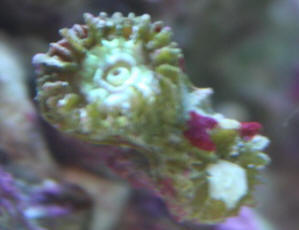
|
Zoa Eating Nudis
6/21/19
Hello,
<Hello Branko>
We are having an issue with Zoa Eating Nudis, we've used Aquaforest Dip after
acclimation of corals on import. It does wonderful job and kills off adults,
however after a while eggs hatch and they start re appearing. Then we redo
dipping on all our corals... its very time consuming and Nudis eventually come
back.
<Yep, they always return>
While looking for more permanent and easier to administer solution, I've come
across posts suggesting use of Salifert Flatworms exit.
<Have worked for me>
Some swear by it, while others say multiple dosage is required, 4times
recommended dose for flatworms. We tried that too, yet Im still seeing happy
Nudis munching on my Zoas :( Is there any chemical way of killing them off while
not harming corals, ideally putting solution into the frag tanks, or chemicals
that we can dip in that will take care of the eggs too. If not what type of
marine life would you suggest to use to fight this pest. I would prefer dealing
with them with Chemicals / inverts rather than fish. I try to keep my frag tanks
fishless, to ensure no type of protozoan parasite will be sold to customers
along with the frags.
<Unfortunately, they are never completely eradicated by just adding chemicals or
dipping, however, I suggest to dip/bath your Zoas for 5-10 minutes in a RO
water/malachite green solution. Another “marine life” option could be the Yellow
Coris Wrasse (Halichoeres chrysus), I know you don’t want to introduce fish to
your frag tank but this one has proved effective.>
Thanks in advance, B.
<Please do keep us posted. Cheers. Wil.>
|
All around Zoa death ... 11/29/09
Hi all:
<Michael>
Forgive my ramble a bit please!
<Is fine>
I have two NanoCube tanks, both 12g, both using MaxiJet 900
pumps. One of the Nanos is the DX, thus has the 50/50 pair of
lights for 48W of light, and the other has a Current USA 18W plus
a little 9W, both with 50/50 bulbs for a total of 27W. Water
conditions are consistently testing well within normal parameters
as far as nitrates, nitrites, ammonia, pH and alkalinity, plus in
my efforts to figure out what is going on, I have been doing
weekly water changes of 20-50%. All my Zoas were looking pretty
good for a reasonable amount of time (2 months or so) and now
they are steadily melting or completely dying.
<These and other Cnidarians are hard to keep in small
volumes>
Frustrated beyond all belief, I did a Lugol's dip yesterday
on the bigger pieces that could withstand dipping (some of my
rocks have other critters on them which might not tolerate the
dip as well) in the hope that there is some bug at issue here,
like flatworms or Zoa spiders. I looked very carefully in the
tank while doing the dip under good bright light and with a
magnifying glass to see if I could actually spot any
"vermin" but in all truth I was only able to see a
couple of 'pods and /possibly/ some flatworms at the bottom
of the dip tank.
<I've expanded and "sharpened" your image as
well/much as I can and see nothing either>
I started the second tank as I felt I was dealing with
allelopathy initially, but I fear I may have complicated matters
instead of simplifying or isolating the root cause. At his point,
all of my Zoa rocks save one are in the process of dying (or so
it seems.) There is some other wildlife in the tanks that appear
to be doing OK ... pulsing Xenias (plentiful and fruitful),
little red "rock anemones" (I don't know what these
are really, but I've included some pictures), various
mushrooms
<All three groups are tough competitors with Zoanthids>
and some cleaning crew crabs and peppermint shrimp. One of the
tanks also has a pipefish who seems to be doing pretty well.
Zoas are really the only thing that I'm seriously interested
in having - the other things are somewhat extraneous, so losing
the Zoas is quite upsetting and I don't seem to be able to
figure out what is going on.
The only things I have not tested are SG and phosphates, although
with the frequency of water changes I am doing, I don't think
these are an issue (although I could be wrong.)
<Not likely an issue>
My water is sourced from Scripps Aquarium here in Southern
California, which is supposed to be NSW equivalent.
<Mmm, was just down there three days back surfing... Not
yesterday, the waves were HUGE! And chatting with a young fellow
filling containers at the base of the pier, four sand filters...
I do hope/trust that you have a S.O.P. for storing, treating this
natural water ahead of use. Do read here re:
http://wetwebmedia.com/seawater.htm
and the linked files above>
Please forgive the terrible pictures ... I tried my best to show
what is going on here:
<I only see one>
In the foreground (fuzzy) are the Zoas that seem to be doing OK
... not great, but OK. In the background is a large rock that
used to be completely populated with green, purple and blue Zoas
- now, everything is melting dying, and the back half of the
piece is completely naked now. I know this is hard to see ... my
apologies!
Here is a picture of one of the rocks with the "rock
anemones" on it ... these appear to be doing well on this
rock. Above this rock is another rock which was moved back into
this tank from the second tank; it used to look even more
"full" than this, but everything is now retracted or
dying:
<Mmm, well... I can't tell/discern what the issue/s might
be here leading to the Zoanthid die-off, but I do know how I
might proceed... I'd drain one of the 12 gallon systems,
carefully (with gloves, eye-protection, outside the system) break
off some of the good/clean/live Zoanthids and re-stock the newly
cleaned systems sans the other groups of Cnidarians>
Using a turkey baster and blowing off the residue, I find that
there are little circular white "rings" that blow off
from around the base of the Zoas ... I can't really tell or
know if these are eggs or webs or what.
<Likely dead tissue from the Sea Mats>
Does this give anyone any ideas on what I'm either doing
wrong or what is going on? This is really driving me to the point
of giving up - I'm normally quite patient and willing to try
and figure things out, but I've done everything I can
possibly think of (albeit from a somewhat newbie
perspective.)
<Unfortunately no... only can guess>
Thanks so much! Let me know if there are more specific things
that I can address/look for.
Michael
<Other than the collective experience we have recorded on WWM
re these organisms, I have nothing further to impart here. Bob
Fenner>
|
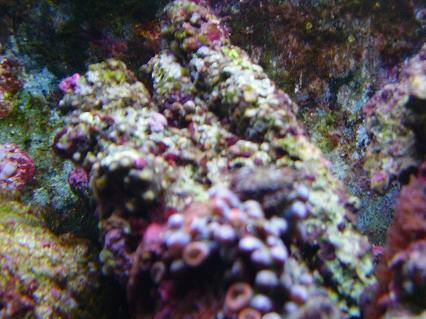 |
|
Worm living inside my Zoa 10/26/09
????
A while back I took some pictures of this worm looking thing
coming in and out of my Zoas, here it is:
This was a while back and eventually I stopped paying attention
to this.
But for the past few days the Zoas have been... not extended to
their full potential and I picked them up to take a close
look.
I saw something that caught my attention. It looked like a shell
that was growing between the polyps. I got a tweezers and broke it
up, turns out to be a tube. Yeah, it looks like there's tube
growing into the Zoas!
<It's just a hitch-hiker tube-dwelling worm of some sort
or another (further ID unlikely). It's nothing to worry about
and not why your Zoas are not extending.>
You can see it right in the middle
WHAT IS THIS?!
<See above.
Cheers,
Sara M.>
|
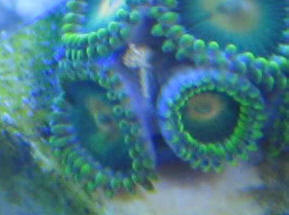 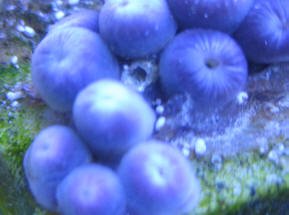 |
|
Nudibranch ID help
05/29/09
I can't find a match for this lil critter, the Nudi.s
body is apprx. 1/4 "long. Thank you, Paul
<Hmm, can you give us any more information? Did you find this
little guy on one of your corals? What corals do you have?
Cheers,
Sara M.>
Re: Nudibranch ID Help: Zoanthid Predator --
5/30/09
<Hello Paul, Lynn here this afternoon.>
I recently set up a new tank, it was a hitchhiker on one of the
frags
<Betcha it arrived on the Zoanthids.>
... it was on the glass, if you zoom in it is actually a
beautiful Nudi
<Yes, it is.>
..but I have it in a specimen cup till I can find out if it is
safe in the tank.
<Good, because it's definitely not safe around your
Zoas.>
It was on the glass not a coral
<Good. What you have looks very much like a notorious Zoanthid
eating Nudibranch. They're mostly a brownish/orange and
white, but take on the color of the Zoas they're preying
upon. For more information, please see the following link,
starting at 'Re: Polyp-feeding Nudibranch' all the way
down through the 'Re: Perhaps a gorgonian feeder?' posts:
http://www.seaslugforum.net/showall.cfm?base=palyfeed
Terrific photo:
http://coralpedia.com/index.php?module=Gallery2&g2_itemId=641
More photos, showing color variation:
http://coralpedia.com/index.php?module=Gallery2&g2_itemId=415
I'd keep a close eye on your Zoas for any indication of
predation or signs of additional Nudi.s. If you see either,
please refer to WWM's FAQ's for removal tips. Just enter
Zoanthid Nudibranch in the Google search engine:
http://www.wetwebmedia.com/Googlesearch.htm
>
..but I have frags of Zoas, pipe organ, Montipora danae,
chalices and good ole GSP in that tank.
<All but the Zoanthids should be in the clear -- at least as
far as these particular Nudi.s go! Take care, LynnZ>
|
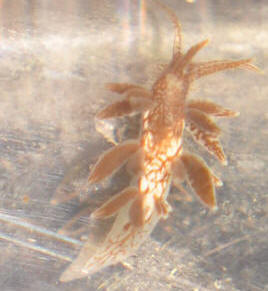 |
Palythoa Polyps Shrinking 5/19/09
I have a lovely brown/pink Palythoa introduced to my 29-gallon cube
about 5 weeks ago. The 8-polyp frag was initially very healthy - large
heads approximately 1 cm in diameter, thick 3/4 inch long stalks and
plump interconnecting mat fibers.
< Sounds nice. I'm a big Palythoa fan myself. >
I placed the colony near the bottom of the aquarium in a well lit area
with good flow. The polyps responded well and accepted food readily.
Within 10 days, the colony started reproducing rapidly, sprouting five
new polyps that grew very quickly. Success - until about two weeks
ago.
Very gradually, the polyps have started to shrink considerably - not
retract, but actually physically shrink. Heads are now just 1/2 cm in
diameter, the stalks have thinned and shortened and interconnecting
mats have thinned. The healthiest polyp has actually grown up an
adjoining rock approximately an inch and attached itself quite
securely. I'm lighting with a single 40 watt 10 K and actinic
compact fluorescent and all water parameters seem in order. I have
added a second single tube standard 15-watt 50/50 10 K florescent and
increased lighting hours hoping that this might be a lighting issue. My
three other small Zoanthid colonies are thriving and growing - only
this small Paly colony seems affected. So, some specific questions:
1) Does this sound like a lighting issue and does the colony simply
need to be moved up to the top third of the tank, or is it more likely
a nutrition/feeding deficiency that is causing this shrinkage?
< It does sound like a lighting issue. I would move the colony up
closer to the light. If you do not see an improvement you may want to
consider a lighting upgrade. >
2) If a move is in order, can I safely sever the now very thin mat
connection with the "polyp on the move" with a razor while in
the tank to allow movement of the main colony? It is not feasible to
remove the two rocks and perform the surgery outside of the main
system.
< Yes , you can use a clean razor to sever the mat. Please use
caution when handling/cutting them. Some people have had extreme
reactions to the toxins present in Zoanthids/Palythoas.
GA Jenkins >
Zoa Pox Treatment -- 05/09/09
Have you any information on treating a reef tank directly with FURAN-2
to treat Zoa pox? any information on the affects on live rock?
<Mmm, yes it can... the route to go here is to place the Zoanthid
colonies in a separate container (outside the system) with some system
water of slightly reduced spg (just add a bit of freshwater), to aid in
absorption... and the Furan-2 made stronger in concentration (250 mg.,
a capsule, to a gallon or so) for an immersion bath... then the Zoas
should be rinsed in another separate container of just some more of
their system water before being returned to the main system or better,
moved to another established tank. Bob Fenner>
Thanks Gregory
Button Polyps, hlth., beh. 04/02/09
Hi
Yesterday I visited my local LFS to have a look at there marine tanks.
They have only been keeping marine fish for about a year, and only have
2 small tanks.
About a month ago they bought in a piece of star polyp, a button polyp
and a white toadstool. At first they looked ok then after a week the
star polyps started to disappear, the button polyp has stayed closed
since, and the toadstool has got a tear in the middle of it, and has
gone grey around bits of the edge.
I asked the girl in the shop what had happened to them but she did not
know, all she said was that this is the second lot of corals that she
has had in, the first lot all died. At first she did have them in a
tank with a lemonpeel, I did tell her that the lemon peel would eat them, then she put
them in the other tank with a Eiblii angel. I suggested to her that I
take them home and see if they would recover in my tank, with better
lighting and more water flow, which she agreed to.
<That was nice of you.>
When I got the button polyps home, I noticed that they looked as if
they were covered in a hard clear coating like varnish, when I put them
in the tank some of this coating started to come off, it just looked
like clear egg shells lifting off and floating in the water, do you
know what this might be?
<The animal is disintegrating/dying.>
Half the rock that the star polyps were on is covered in coralline
algae and the half that the polyps were on is all brown, like fine
algae, as the evening went on I did notice small light coloured stalks
appear through the
brown muck, so hopefully they might re appear, what do you think?
<It sounds like the coral might still be alive... but in bad
shape.>
The toad stool looks as if it is molting as there is thin bits like
skin coming off.
<It could be shedding due to stress.>
I have only had my marine tank up and running for 4 months and all the
corals that I have, are growing well and looking very healthy, I could
not let the corals in the shop die. There are only 2 other people on
the
island that keep marines, so I had to try something, do you think I did
the right thing? any help and advice would be most helpful.
<Well, it just depends... I don't usually encourage people to
"rescue" LFS animals because, like any business, a LFS will
keep taking in whatever it can sell (sick or not). But, if the LFS let
you have these corals for free because they couldn't care for them,
then I commend you for saving them without supporting a bad business
practice. However, if you paid for them, I would caution you that doing
so will only encourage the store to get more (without necessarily
learning anything). If you want to be extra-super, you could offer to
help the LFS learn how to care for these animals so that if they order
any more, they will know what to do.>
Another question I have for you (sorry), I have a friend that works at
a water test center, where they breed Acartia tonsa copepod and brine
shrimp,
<Neato>
She gives me small amounts every few weeks for my tank, can I put too
much Acartia in, or is there no limit to the amount that I could put
in.
<Well, you can have too much of anything... I would put in as many
as your fish/coral can eat and as can survive in your system without
dying and causing water quality issues.>
The fish seem to love hunting them and the excess seem to crawl about
the glass and on the live rock and bottom, will they do any other good
in the tank, like eat some of the algae etc?
<Possibly... but I wouldn't use them for this purpose. Please
see here:
http://www.caspianenvironment.org/biodb/eng/zooplankton/Acartia%20tonsa/main.htm>
Could I over feed the tank with them?
<If they're staying alive in the tank until they are eaten, then
I doubt it. Again, I would only be concerned if you put sooo many in
that they started to die off (without being eaten) and cause water
quality issues.
But so long as they stay alive, I don't think they would be much a
problem... they might even be beneficial.>
as I can get as much as I want from her. She also supplies me with
Phyto plankton, how much should I put in the tank at one time? My tank
is 6 x 2 x 2 and I also have a sump that holds 22 US gallons.
<Hmm, it depends on if the phytoplankton is live and if it is
concentrated or not and how many filter feeders you have in the tank.
In any event, I would start with small doses and slowly increase until
you get the "right"
amount.>
Thanks great web site
Kenny
<De nada,
Sara M.>
Re: Button Polyps 04/03/09
Hi
Do you think there is no hope for the button polyps or the star?
<I do think there is hope still. I "never say never" with
button polyps.
They seem to be able to come back from just about anything.>
Should I take the button out or leave it to see what happens could it
affect the rest of my corals in some way if I left it?
<If your tank is larger and these are just "frags"... then
the tank should be able to process any nutrients from a bit of die off.
But if you think they're affecting your water quality, it's
your call to remove them or not.>
I could not open the web address that you sent me about the
Acartia.
<Sorry, the site seems down right now for some reason. I'd try
again later.>
Thanks
Kenny
<De nada,
Sara M.>
Re: Button Polyps... referral? 04/03/09
Hi
The button polyps are on a rock about 4in round, they are all over the
rock, there must be at least 100 polyps maybe more. Each polyp is about
3/16 of an inch in diameter, there still seems to be a bit of colour in
them and you can see a hole in the center of them just like my other
button polyps that I have, when they are closed at night, or if
something touches them.
<These are good signs. I do think they can/will pull through with
proper care.>
I will keep an eye on them, and keep my fingers crossed.
I got all the corals for nothing.
<Cool.>
Thanks again
Kenny
<Good luck,
Sara M.>
Re: Button Polyps 04/04/09
Hi Sara
This morning I had a look at the button polyps, there was a white
covering all over them, looked like spiders webs. I blasted water at
them with a syringe and blow most of it off. Early this evening I was
looking at them again, and around the one side there are about 10
polyps open, looking better than the last few days.
<good to hear>
The phytoplankton that I get is live, it is a mixture of 2 types, not
sure which types they are.
The last 2 time I only asked for 100mls and add 50 to the tank at the
time,
<This should be fine.>
and add some to the sump. Is this too much to add at one time? Could
the phyto add to the growth of algae in the tank?
<It could if either 1) the culture is high in nutrients or 2) if you
don't have enough filter feeding organisms to consume it and it
dies. But I think you're safe with those small doses.>
Thanks
Kenny
<Cheers,
Sara M.>
|
Snails, Zoa Deaths, and good pix. 02/11/09
Howdy! First off my wife and I had the pleasure of meeting Mr.
Fenner in Dallas at the Next Wave 2009 event. He gave the most
dynamic, and informative presentation. The other presenters had
good info, but they were geeks ( in a good way, really :)
<Thank you for saying this re Mr. Fenner's presentation. I
always try to tell him he's the best, but he thinks I'm
just "sucking up" or something. I've been to a lot
of marine aquarium conferences/presentations, and many are
interesting... but (imo) none are as equally informative and
entertaining/well presented as Roberto's.><<Ho buoy!
RMF>> Now for my questions. 1: Our Zoas are dying off in
patches. We have tried RO and Lugol's dips to make sure we
don't have spiders or any other evil critters. Well, we found
Sun Dial snails. How the heck do we get rid of them? <You have
to quarantine the Zoanthids and meticulously remove all the
snails... and, as gently as possible, scrap off all the snail
eggs.> We removed 3 or 4, but we keep finding one or two every
now and again. We really want to put more Zoas in, but when?
<You need to quarantine the infected colonies asap. I
wouldn't add anymore Zoanthids until you haven't seen any
snails for at least 2 weeks.> 2: We set up a pico tank and
found the coolest hitch hikers. We think the coral is a
Caulastrea. It is in bad shape, but seems to be getting better!
The other is a beautiful snail, any ideas on what it is? Is it
evil? <It's difficult to ID snails from photos... but I do
think this is one of the Nerite sp. of snails (usually
beneficial).> The pix are attached. You can find the originals
at
http://william1034.smugmug.com/gallery/7329746_Q9Y4q/1/471608269_j6LtS
We are still learning so please leave comments with the pictures.
William <Cheers, Sara M.> Btw, you might want to collect
those snails and sell/give them to someone with a Zoanthid
"problem." I do recall going around with a friends,
actually looking for these little guys because their Zoanthids
were growing out of control (as tends to happen). Though
they're a pest for those just starting out with small
Zoanthid colonies (and for those in love with these corals),
they're actually appreciated/welcomed by some with more stony
coral focused systems (that happen to have some stray Zoanthids
run wild). Cheers,
Sara M.
|
 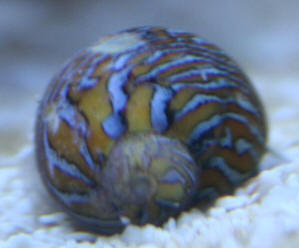 |
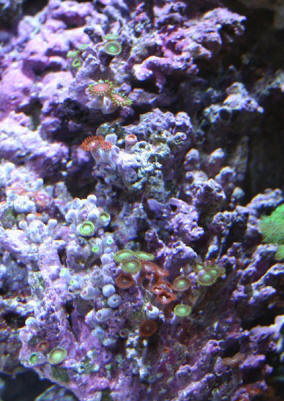 |
|
Button polyps, beh., hlth. 1/26/09 Hi. I am
new to saltwater and tried to look through the forum to find my
answers before emailing but didn't quite see the same problem
that I have going on. If it was there and I missed, I apologize.
I bought some button polyps from my local fish store. After about
3 weeks in my tank, they started getting this white film on some
of the polyps; I attached a picture. The colony seems very
healthy but I was hoping that this isn't some kind of fungus
or disease starting. Could you please tell me what this is?
<Mmm, nothing appears too amiss here... It often happens that
Zoanthids (et al. similar sea life) will "look
different" being moved... conditions like lighting,
circulation being different, along with general stress in being
relocated> I have a 46 gallon that has been up and running for
about 6 months. I started with water, live rock, and live sand
form an existing aquarium so my tank cycled in a month or so. I
haven't had any problems with any other livestock that is in
my tank. My water parameters are: Salinity 1.022 <Mmm, this is
too low... should be near natural seawater strength...
1.025-1.026...> Nitrate maybe 5 but close to 0. Nitrite 0
Hardness 400 Alkalinity 300 PH 8.4 Calcium 420 Iodine- just did
my first test and it read 0 but the reference water that was sent
with the kit was to be .06mg (ideal natural saltwater according
to the test kit parameters) and it read .01mg so I don't know
how reliable this new kit is. <Mmm, I2 comes and goes... you
should read a bit re its use in captive systems... If anything,
I'd dose during water changes... "It" will
generally read zero most all the time otherwise> Any help
would be greatly appreciated. Tammy <There may be a bit of
"allelopathy" going on here with other Cnidarians... If
your Zoanthids continue to further whiten... I'd be reading
here: http://wetwebmedia.com/cnidcompppt.htm and the linked files
above. Bob Fenner>
|
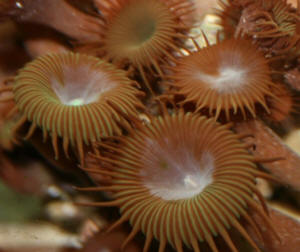 |
|
Re: button polyps, beh./comp., hlth.
1/27/2009 Thank you for the reply. I will start to raise
the salinity and I'm glad at this time you don't see
anything wrong with the polyps. It's a colony of about 25 or
so and I really like them. I also read your article which was
very informative and helped. I only have a button polyp, 2 very
small star polyps, a small yellow polyp, and some Ricordea in my
tank very separated. Would there still be some allelopathy if
they are at least 5-10 inches from one another? <Could indeed,
yes... the organisms listed are not "very"
compatible... can/do mal-influence each other distally... through
chemical means> I have very good water flow thinking that
would help. I also have 2 sea fans that are separated from all
the other items if that matters. I tried to read up on everything
while I was buying to make sure I wasn't putting competitors
in but maybe I did.? <Happens...> Thanks again! Tammy
<Welcome my friend. Please do keep good notes, and inform us
in a month or so re progress here. BobF>
Re: button polyps, comp.
1/27/09 Thanks, I will. I thought I was doing good with
compatibility but as you say, it happens. Would an extra skimmer
or more water flow keep things moving around enough and clean the
water of the chemicals they put off? <Does help> I have a
SeaClone 100 skimmer, a maxi-jet 1200 power jet, and a Fluval
canister running... Should I get something else to help?
<Please read where you were first referred to... archived
below> I hope they all do ok and I will keep you posted.
Thanks again for all the information and the quick responses!
Great forum... I have read a lot of pages! Tammy <Ahh! Keep
moving forward. BobF>
|
|
|

